June 10 to June 16
The New Taiwan dollar (NTD) was never meant to be the nation’s official currency, and over the decades many questioned why a government that claimed the entire China used it as its de facto national tender. A 1953 United Daily News editorial suggested that it be renamed the “Free China National dollar,” while others urged the government to abolish the “regional” NTD and establish a true national currency.
However, the Chinese Nationalist Party (KMT) could not afford any more massive financial crises that had marred Taiwan and China during the late 1940s. The financial system had finally stabilized with US aid, and they were concerned that any change to the currency would lead people to panic and spark rampant inflation again. They decided to wait for a more opportune time to make the change — preferably after defeating the communists and retaking China.
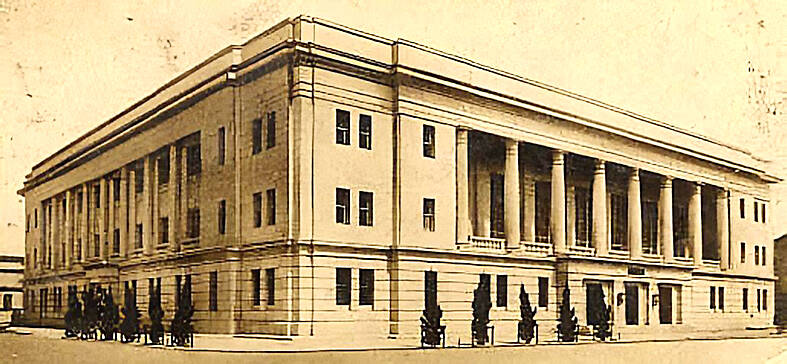
Photo courtesy of Wikimedia Commons
In the meantime, the legal tender was the silver yuan, which was never circulated in Taiwan. This led to much confusion at first — for example, fees and fines were often posted in silver yuan, and people would think it was NTD and prepare the wrong amount of money.
In 1961, the newly revived Central Bank — which was in charge of issuing the national currency — took over the issuing of NTD from the Taiwan Bank. By this time the NTD was Taiwan’s national currency in all but name only, especially after the 1962 Constitutional Interpretation No. 99 ruled that forging NTD would fall under the Penal Act of Offenses Against National Currency.
Taiwan was no longer at war with the lifting of the Temporary Provisions Effective During the Period of National Mobilization for Suppression of the Communist Rebellion (動員戡亂時期臨時條款) in 1991. The silver yuan was abolished that year, and the nation was actually left without a national currency until the NTD was made official in July 2000.
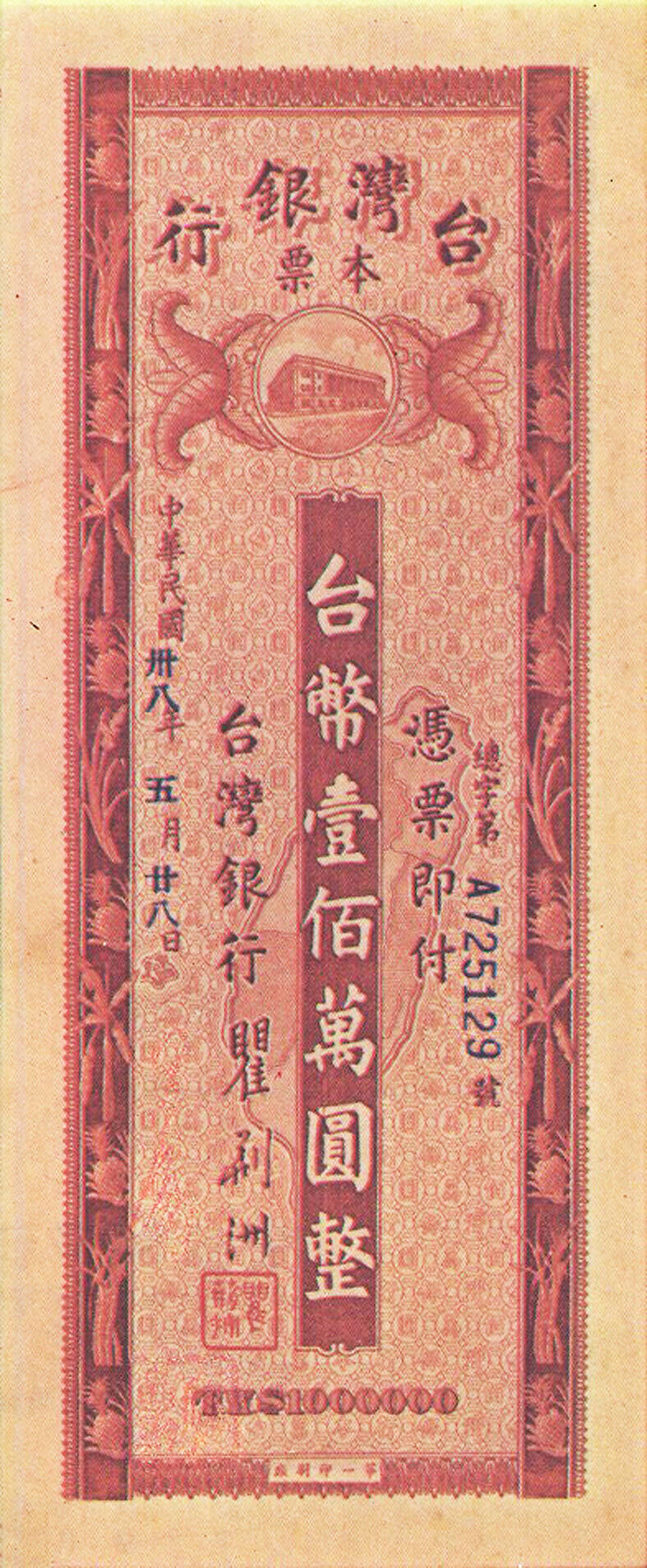
Photo courtesy of Wikimedia Commons
OLD TAIWAN DOLLAR
The KMT began making plans on how to manage Taiwan’s financial system before the end of World War II. Due to hyperinflation in China, the 1943 “Draft plan for postwar management of Taiwan’s finances” (戰後處理台灣金融方案草) stated that Taiwan should maintain it's independent financial system at least temporarily and have it’s own regional currency, not unlike their plans for Japanese-occupied Manchuria.
The Central Bank and other Chinese banks were to stay out of Taiwan, in order to minimize the impact of the financial chaos in China on Taiwan. At this time, the official currency in Taiwan was the Taiwanese Yen, issued by the Taiwan Bank, which the Japanese colonial government established in 1899.
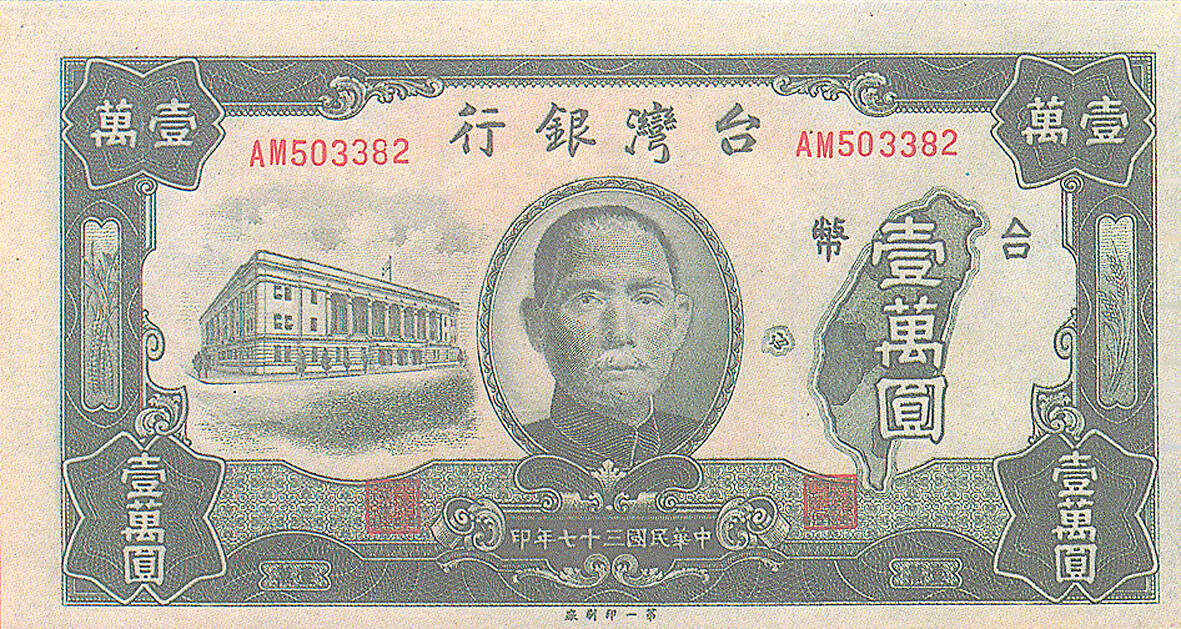
Photo courtesy of Wikimedia Commons
In the study “From regional currency to national currency: The debate and impact on the status of the Taiwan dollar” (從地方貨幣到國幣 台幣地位相關爭議及其影響), Su Chia-yao (蘇珈瑤) writes that not everyone agreed to this proposal. Finance minister Yu Hung-chun (俞鴻鈞) insisted that the Central Bank take over Taiwanese financial affairs and tried to push through a new scheme, but Taiwan governor-general Chen Yi (陳儀) argued that doing so would lead to inflation, confusion and cause people to lose faith in the government.
In the end, KMT leader Chiang Kai-shek (蔣介石) agreed with Chen, and Taiwan Bank continued to issue temporary Taiwanese bank notes. On May 21, 1946, the bank printed its first Taiwan dollars, today known as Old Taiwan dollars (OTD). The goal was to first phase out Japanese-era money, and when China had stabilized enough, to slowly recall the OTD notes and unify the nation’s currency.
FINANCIAL DISASTER
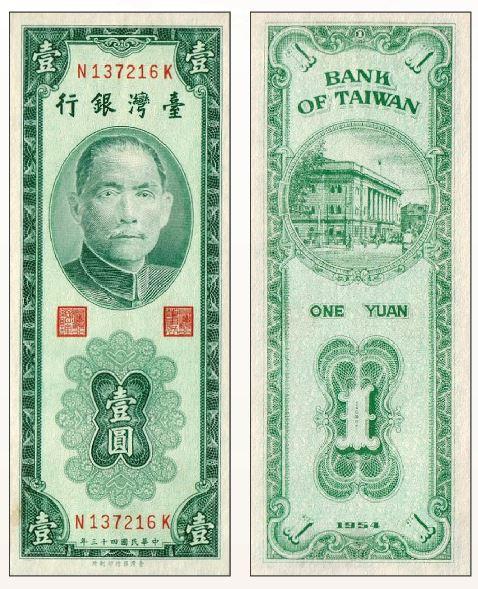
Photo courtesy of Wikimedia Commons
However, the measures failed as inflation ran wild in Taiwan. Wu Tsung-min (吳聰敏) writes in “Hyperinflation in post-war Taiwan, 1945-1950” (臺灣戰後的惡性物價膨脹) that Taiwanese Yen was already extremely inflated by 1945 due the Japanese over-issuing bank notes to support the war effort. The colonial government had kept things from spiraling out of control by enforcing strict price controls on goods, but that ended when they left.
At first, the OTD was issued in $1, $5 and $10 notes, but $50 and $100 notes were soon added. Despite being financially separate, Taiwan was not immune to the events in China especially as the Chinese Civil War heated up. The KMT’s use of state enterprises in Taiwan and Taiwanese money to support the war, coupled with budget deficits, caused prices to soar and the OTD to decrease in value; by 1948 the bank was printing $10,000 bills and $1 million bearer’s checks. According to a National Development Council document, a kilo of rice cost $1.6 million and one duck egg went for $5,000 at the height of the inflation.
Finally, the government launched the New Taiwan dollar on June 15 1949, at an exchange rate of 40,000 to one. Although this curbed inflation, it greatly affected people’s livelihoods. Goods remained in short supply, and the influx of refugees from China didn’t help. As a result, the government still ended up in the red every fiscal year.
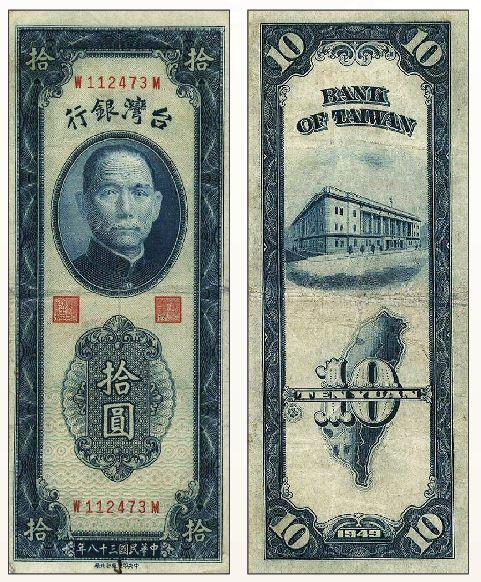
Photo courtesy of Wikimedia Commons
The nation remained in financial trouble until the Korean War broke out in June 1950. To prevent Taiwan from falling to communism, the US started sending aid again. Between 1951 and 1953, more than US$284 million worth of goods and other services came to Taiwan, greatly trimming the national budget deficit.
BECOMING OFFICIAL
The NTD was pretty much stable by 1953. Taiwan Bank had been essentially functioning as the Central Bank since 1949, but due to it falling under the provincial government, it did not have the authority to be a true national bank. The Central Bank was reinstated in 1961, and one of its functions was to oversee the issuing of the NTD — although it was still carried out by Taiwan Bank.
“NTD has been in use in Taiwan for 10 years now, and although there has been slight deprecation, it is an established, trustworthy currency. As of now, it’s unsuitable to replace it, as doing so will cause psychological distress to the citizens,” the official plan stated.
They also noted that having regional currencies would be beneficial in the war to retake China and the subsequent rebuilding effort, and only then would they need to establish a new national currency.
By the 1990s, the government no longer sought to retake China, but now they were still reluctant to make the NTD the official currency as it might suggest Taiwanese independence. These concerns faded over the decade, and in 1998, the Central Bank fully took over the issuing of NTD, redesigning the bills with new graphics and advanced security features, and replacing the words “Taiwan Bank” with “Central Bank.”
The 51-year-old debate finally concluded on Jan. 16, 2000, when the Executive Yuan enacted the Regulations Governing the Issuance of New Taiwan dollars by the Central Bank of China, which clearly states, “The currency of the ROC is the New Taiwan dollar.”
Taiwan in Time, a column about Taiwan’s history that is published every Sunday, spotlights important or interesting events around the nation that either have anniversaries this week or are tied to current events.

On April 26, The Lancet published a letter from two doctors at Taichung-based China Medical University Hospital (CMUH) warning that “Taiwan’s Health Care System is on the Brink of Collapse.” The authors said that “Years of policy inaction and mismanagement of resources have led to the National Health Insurance system operating under unsustainable conditions.” The pushback was immediate. Errors in the paper were quickly identified and publicized, to discredit the authors (the hospital apologized). CNA reported that CMUH said the letter described Taiwan in 2021 as having 62 nurses per 10,000 people, when the correct number was 78 nurses per 10,000

As we live longer, our risk of cognitive impairment is increasing. How can we delay the onset of symptoms? Do we have to give up every indulgence or can small changes make a difference? We asked neurologists for tips on how to keep our brains healthy for life. TAKE CARE OF YOUR HEALTH “All of the sensible things that apply to bodily health apply to brain health,” says Suzanne O’Sullivan, a consultant in neurology at the National Hospital for Neurology and Neurosurgery in London, and the author of The Age of Diagnosis. “When you’re 20, you can get away with absolute

May 5 to May 11 What started out as friction between Taiwanese students at Taichung First High School and a Japanese head cook escalated dramatically over the first two weeks of May 1927. It began on April 30 when the cook’s wife knew that lotus starch used in that night’s dinner had rat feces in it, but failed to inform staff until the meal was already prepared. The students believed that her silence was intentional, and filed a complaint. The school’s Japanese administrators sided with the cook’s family, dismissing the students as troublemakers and clamping down on their freedoms — with

As Donald Trump’s executive order in March led to the shuttering of Voice of America (VOA) — the global broadcaster whose roots date back to the fight against Nazi propaganda — he quickly attracted support from figures not used to aligning themselves with any US administration. Trump had ordered the US Agency for Global Media, the federal agency that funds VOA and other groups promoting independent journalism overseas, to be “eliminated to the maximum extent consistent with applicable law.” The decision suddenly halted programming in 49 languages to more than 425 million people. In Moscow, Margarita Simonyan, the hardline editor-in-chief of the